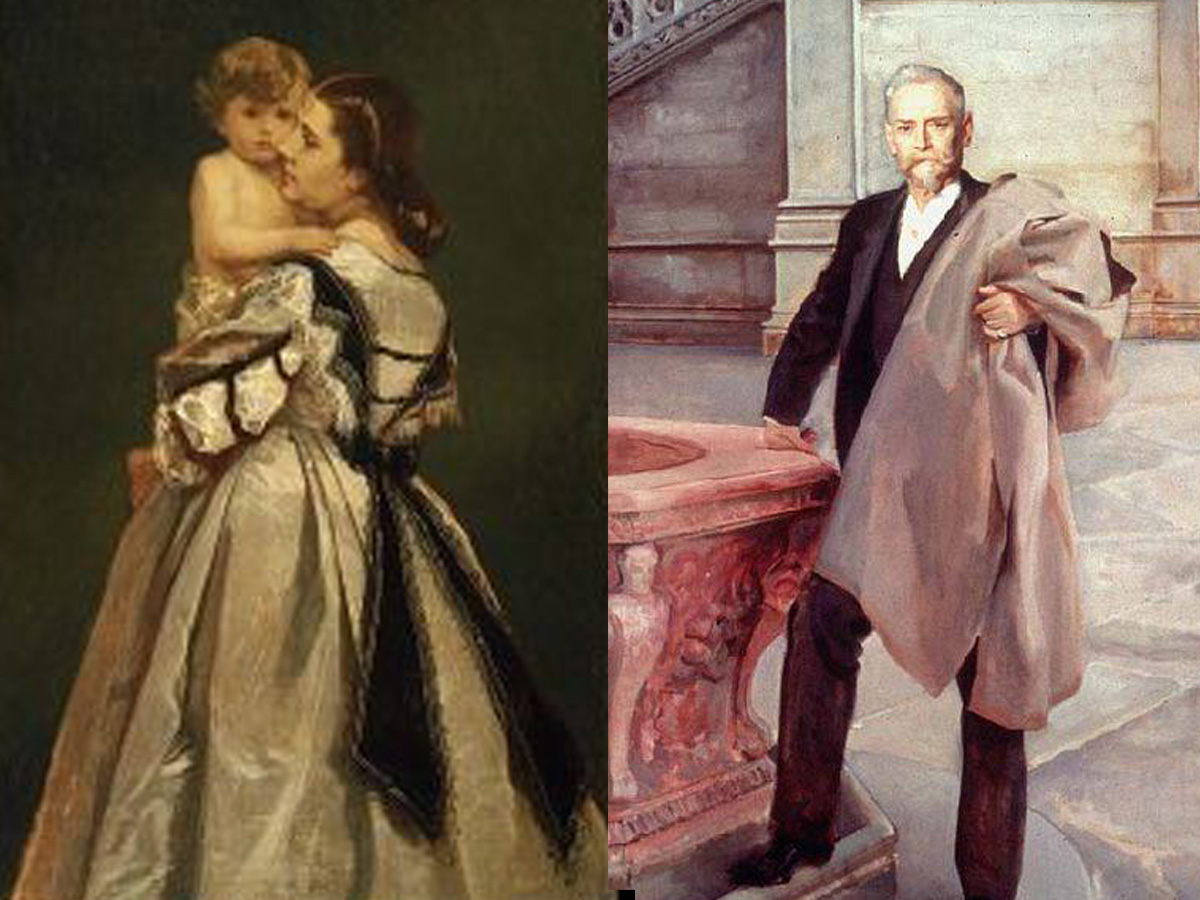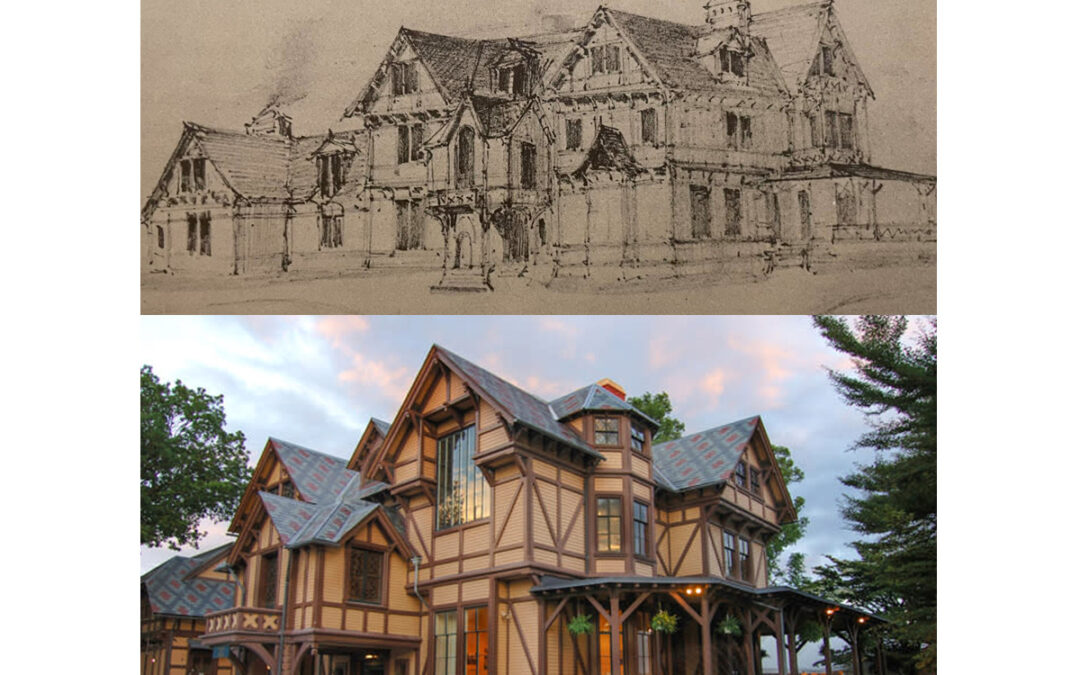JNA Griswold Design Sketch (Above) and the completed house (Below), 1864
Richard Morris Hunt (1827-1895) was the first American citizen to be admitted to study at the École des Beaux Arts, the preeminent school of art and architecture in the world during the 19th century. He became the architect for the Vanderbilt family and is well known for his Gilded Age palaces they commissioned from him. These grand homes include the likes of The Breakers, Marble House, and Ochre Court in Newport, Rhode Island and others like Biltmore in Ashville, South Carolina. Biltmore is still the largest private home ever built in the United States and has over 140,000 square feet of space.

View from the École des Beaux Arts
Hunt’s early career however was equally important to his development and the evolution of American architectural education and design. When Hunt first returned from Paris at the end of 1855, he opened an office in New York at the age of 28. Upon discovering that there were no American schools of architecture, he opened a studio for educating young men in the same manner as he had been trained in Paris. Among the many alums who participated in this school was William Ware (1832-1915), who after dissolving his Boston architectural practice and moving to New York, then founded the MIT School of Architecture in 1865 and then the Columbia School of Architecture in 1881. These are among the earliest schools of architecture in university settings, and they owe much of their foundational teachings to Richard Morris Hunt and his students. Other Hunt students included George Post, Henry Van Brunt, and Frank Furness, all of whom went on to have successful and influential architectural careers around the country. Based on Hunt’s stature and prominence in the emerging profession, he became widely known as the “Dean of American Architects”, even in his own time.

Catharine Howland Hunt (Left) and Richard Morris Hunt (Right)
Hunt traveled back and forth between New York and Newport, but his practice and prospects improved greatly after his 1860 marriage to Catharine Clinton Howland, an heiress with plenty of Newport connections. He and his wife set sail for Europe to begin an 18-month honeymoon at the very time the storm clouds of war were gathering over the United States, signaling the inexorable approach of the American Civil War. Many other wealthy young Americans were spending their time in Europe and traveling in similar circles around these years as well. This includes John Griswold, who would become a noteworthy client for Hunt and provide an important steppingstone to his later fame and prosperity. Many contemporary accounts of people meeting Hunt comment on his charm, affability, and good nature. He was loved by his students, employees, clients, and fellow architects alike. In addition to founding his architectural studio, he helped create the American Institute of Architects, the New York Municipal Art Society, and other professional and philanthropic organizations.

Hypotenuse House by Richard Morris Hunt, 1870
Upon returning from his honeymoon, he undertook the house for JNA Griswold (which became the Newport Art Museum) and a speculative house on the south end of Bellevue Avenue now called Le Chalet. He and his wife had a comfortable estate on the current site of the Viking Hotel called Hilltop. Among the outbuildings on the site was the structure now known as Hypotenuse House, which was relocated to Catherine Street when the estate was sold for redevelopment. Sadly 12 other houses that Hunt had designed in Newport in the period before 1875 were lost to the extraordinary development that occurred in the Gilded Age period following the purchase of Beechwood Mansion in 1881 by Mr. and Mrs. William Backhouse Astor. Mrs. Astor was the queen of New York society at that time, and where she and her husband went, wealth soon followed.

The Travers Block by Richard Morris Hunt, 1880-81
Another noteworthy Hunt building that is still in existence is the Travers Block, which was constructed in 1870-71. This is a mixed-use commercial structure on Bellevue Avenue immediately adjacent to the Newport Casino built somewhat later in 1880 along the most commercial portion of the street. Like the majority of his pre-1875 work, this building exhibits the elements of stick style design as it was later defined by Yale Architectural Scholar Vincent Scully in his seminal book The Shingle Style and the Stick Style. This style hinted at European models like the Swiss Chalet architecture, but showed a fresh mindset and inventiveness that made this architectural style feel uniquely American. It was a byproduct of Hunt’s concern for the past as well as confidence in designing in an original manner.

Comparison of Richard Morris Hunt in his younger years (Left) and his later (Right)
Following 1875 Hunt would tend to design in a style that was more derivative of grand European models as the size and budget of his projects increased during the building boom of the Gilded Age. Any yet, it is Hunt’s early years that set the trajectory of his career integrating design, education, and organization building throughout his life. His premature death in 1895 occurred and the end of his career occurred right at the height of his fame and influence. One wonders what more he could have created and accomplished had he been given more time to design and build.
Ross Cann, RA, AIA, LEED AP, is an author, historian, and practicing architect living and working in Newport, RI. He holds honor degrees in Architectural History and Design from Yale, Cambridge, and Columbia Universities. He is currently teaching a course on Hunt and his early years for The Circle of Scholars Program at Salve Regina University.

Fascinating and brilliant article. Enjoyed learning more about RMH’s early life/career.